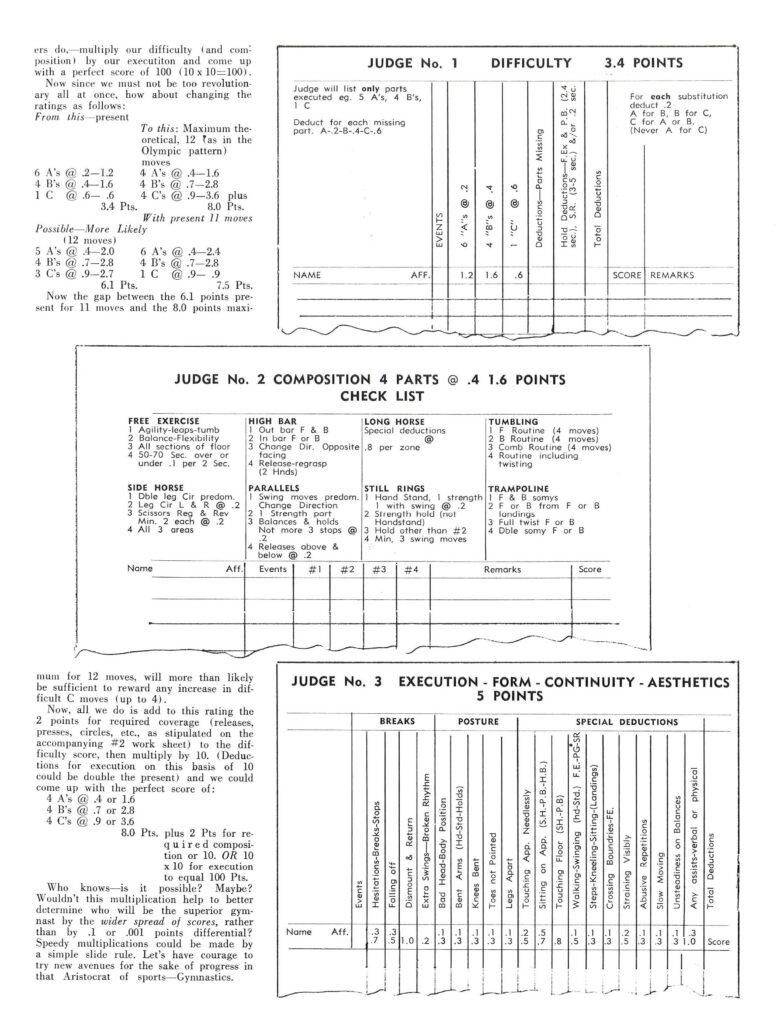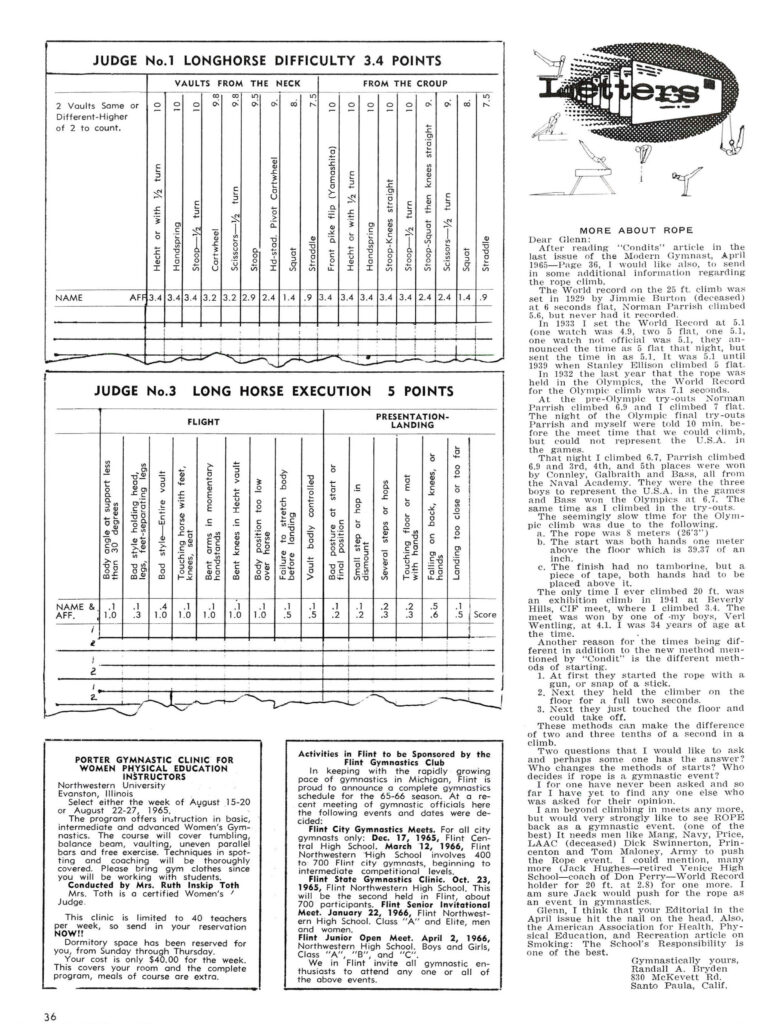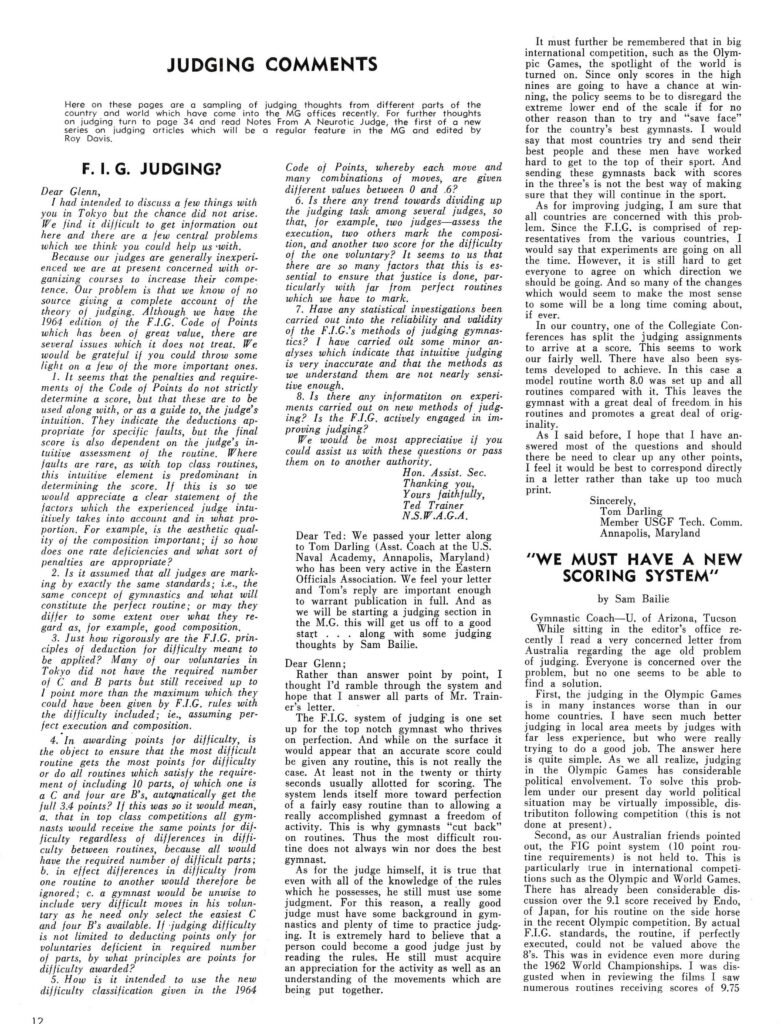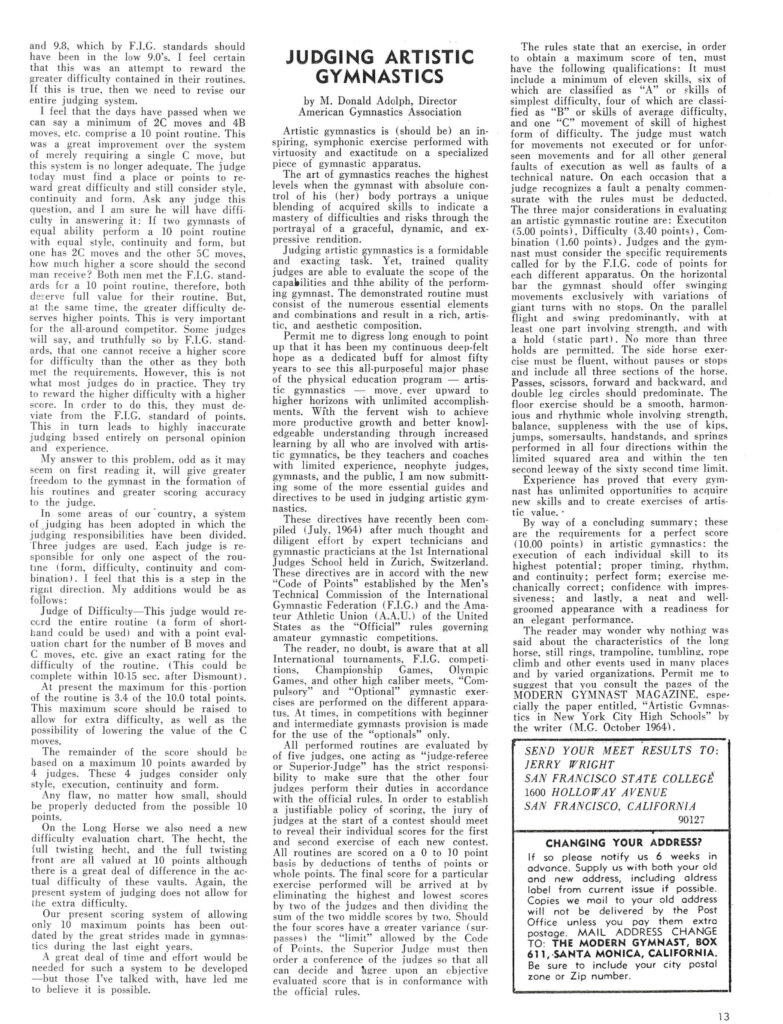A quick recap: At the 1964 Olympics, Endo Yukio won the all-around competition after a questionable pommel horse routine. He had 3 major breaks during his routine. Yet, he received a 9.10, and gymnastics fans were outraged about the overscoring.
The pages of Modern Gymnast were filled with letters and articles about the Code of Points and judging. The responses ranged from insults hurled at the creators of the Code…
Obviously these [difficulty] ratings were made by someone who had never done very much work on the side horse, someone who is completely out of date, or someone who had only minor accomplishments in the event.
Modern Gymnast, February 1965
…to more helpful suggestions, such as these judging sheets:


But I want to reprint a letter from Sam Bailie, the coach at the University of Arizona. It is the clearest summary of what the 10.0 detractors were thinking.
Don’t worry. For those short on time, I’ll give you the TL;DR at the end.


While sitting in the editor’s office recently I read a very concerned letter from Australia regarding the age-old problem of judging. Everyone is concerned over the problem, but no one seems to be able to find a solution.
First, the judging in the Olympic Games is in many instances worse than in our home countries. I have seen much better judging in local area meets by judges with far less experience, but who were really trying to do a good job. The answer here is quite simple. As we all realize, judging in the Olympic Games has considerable political involvement. To solve this problem under our present-day world political situation may be virtually impossible distribution following competition (this is not done at present).
Second, as our Australian friends pointed out, the FIG point system (10 point routine requirements) is not held to. This is particularly true in international competitions such as the Olympic and World Games. There has already been considerable discussion over the 9.1 score received by Endo, of Japan, for his routine on the side horse in the recent Olympic competition. By actual F.I.G. standards, the routine, if perfectly executed, could not be valued above the 8’s. This was in evidence even more during the 1962 World Championships. I was disgusted when, in reviewing the films, I saw numerous routines receiving scores of 9.75 and 9.8, which by F.I.G. standards should have been in the low 9.0’s. I feel certain that this was an attempt to reward the greater difficulty contained in their routines. If this is true, then we need to revise our entire judging system.
I feel that the days have passed when we can say a minimum of 2C moves and 4B moves, etc. comprise a 10 point routine. This was a great improvement over the system of merely requiring a single C move; but this system is no longer adequate. The judge today must find a place or points to reward “real difficulty and still consider style, continuity, and form. Ask any judge this question, and I am sure he will have difficulty in answering it: If two gymnasts of equal ability perform a 10 point routine with equal style, continuity, and form, but one has 2C moves and the other 5C moves, how much higher a score should the second man receive? Both men met the F.I.G. standards for a 10 point routine, therefore, both deserve value for their routine. But, at the same time, the greater difficulty deserves higher points. This is very important for the all-around competitor. Some judges will say, and truthfully so by F.I.G. standards, that one cannot receive a higher score for difficulty than the other as they both met the requirements. However, this is not what most judges do in practice. They try to reward the higher difficulty with a higher score. In order to do this, they must deviate from the F.I.G. standard of points. This in turn leads to highly inaccurate judging based entirely on personal opinion and experience.
My answer to this problem, odd as it may seem on first reading it, will give greater freedom to the gymnast in the formation of his routines and greater scoring accuracy to the judge.
In some areas of our country, a system of judging has been adopted in which the judging responsibilities have been divided. Three judges are used. Each judge is responsible for only one aspect of the routine (form, difficulty, continuity, and combination). I feel that this is a step in the right direction. My additions would be as follows:
Judge of Difficulty- This judge would record the entire routine (a form of shorthand could be used) and with a point evaluation chart for the number of B moves and C moves, etc. give an exact rating for the difficulty of the routine. (This could be completed within 10-15 sec. after dismount).
At present, the maximum for this portion of the routine is 3.4 of the 10.0 total points. This maximum score should be raised to allow for extra difficulty, as well as the possibility of lowering the value of the C moves.
The remainder of the score should be based on a maximum 10 points awarded by 4 judges. These 4 judges consider only style, execution, continuity and form. Any flaw, no matter how small, should be properly deducted from the possible 10 points.
On the Long Horse we also need a new difficulty evaluation chart. The hecht, the full-twisting hecht, and the full twisting front are all valued at 10 points although there is a great deal of difference in the actual difficulty of these vaults. Again, the present system of judging does not allow for the extra difficulty.
Our present scoring system of allowing only 10 maximum points has been outdated by the great strides made in gymnastics during the last eight years.
A great deal of time and effort would be needed for such a system to be developed – but those I’ve talked with, have led me to believe it is possible.
TL;DR
Problem #1: Gymnastics judging is political.
- He doesn’t have a solution for this problem.
Problem #2: Judges aren’t strictly following the execution deductions in the Code of Points. (For example, Endo’s pommel horse routine at the Tokyo Olympics.)
Problem #3: Requiring 4 Bs and 2 Cs is no longer sufficient. Gymnasts are performing far more than that.
Problem #4: Judges are more lenient with gymnasts who perform more difficulty than is required.
His brain teaser: If two gymnasts of equal ability perform a 10 point routine with equal style, continuity, and form, but one has 2C moves and the other 5C moves, how much higher a score should the second man receive?
His Solution
- Divide the judging duties
- 1 judge dedicated to difficulty using a type of shorthand
- Aha! That’s where our judging symbols come from!
- 4 judges dedicated to style, execution, continuity, and form
- “Any flaw, no matter how small, should be properly deducted from the possible 10 points.”
- The panel of 4 judges take their deductions out of a 10.0
- The difficulty judge separately gives a difficulty rating to the routine
- 1 judge dedicated to difficulty using a type of shorthand
- Rework the difficulty charts because the difficulty values no longer reflect the difficulty being performed
Sounds a lot like the open-ended Code today, huh?
Why does this matter? Over the years, the gymnastics community has constructed narratives about why the 10.0 disappeared, but those narratives rarely recognize that members of the gymnastics community had been questioning the 10.0 since as early as the 1960s.
A Note on the “Perfect” 10
When it comes to the 10.0, there tended to be two camps: those who saw the 10.0 as a measure of perfection and those who saw the 10.0 as the maximum number of points.
In Bailie’s letter above, he never says the “perfect 10.” He talks about “total points” or “maximum points.” For this camp, a gymnast could receive 10 points without being described as “perfect” and all the cultural baggage that came with that adjective.
But there were people who referred to a 10.0 as a “perfect score.” Donald Adolph, the director of the American Gymnastics Association, was one of them. In his letter in Modern Gymnast, he wrote:
By way of a concluding summary; these are the requirements for a perfect score (10.00 points) in artistic gymnastics : the execution of each individual skill to its highest potential; proper timing, rhythm, and continuity; perfect form; exercise mechanically correct; confidence with impressiveness; and lastly, a neat and well groomed appearance with a readiness for an elegant performance.
Modern Gymnast, March 1965
When you add the adjective “perfect” in front of the 10.0, you add a myriad of connotations. It is no longer just about a gymnast’s gymnastics skills; it’s also about a gymnast’s appearance, for example.
I want to eye-roll at Adolph’s reference to “a neat and well-groomed appearance.” But, to be quite frank, if we fast forward 11 years to Montreal, Nadia’s appearance was probably one of the reasons why she became associated with perfection.
And I mean her appearance in all aspects — not just the tidiness of her ponytail and youthful looks, but the fact that she was a white European.
In the New York Times, Nadia was called a “Barbie doll with bangs.” Meanwhile, Nellie Kim was seen as a racial “other” whom the white media world didn’t know how to categorize: “Nelli Kim, who looks Oriental but was born in Shurad City in the region around Leningrad…”
Only one of them would become synonymous with perfection in the sport… 🤔
Anyway, I digress. We’ll dive deeper into that subject when we get to 1976.
Back to my point about semantics: Nadia — and, more specifically, what she came to represent — didn’t come out of nowhere. Nadia wasn’t a goddess who descended from the heavens to show us, mere mortals, what perfection looked like.
Just as the history of the open-ended Code of Points started long before 2006, the notion of what constituted a “perfect” 10.0 was being developed and constructed long before Nadia swung bars in Montreal.
One reply on “1964: Questioning the 10.0 Again”
So many great ideas that would take so long to enact… An open-ended Code of Points, splitting judges’ responsibilities, the use of judging shorthand. However, there was some progress made to improve judging in this era. 1964 was the first full Intercontinental Judges’ Course, examination and FIG Brevet certification.